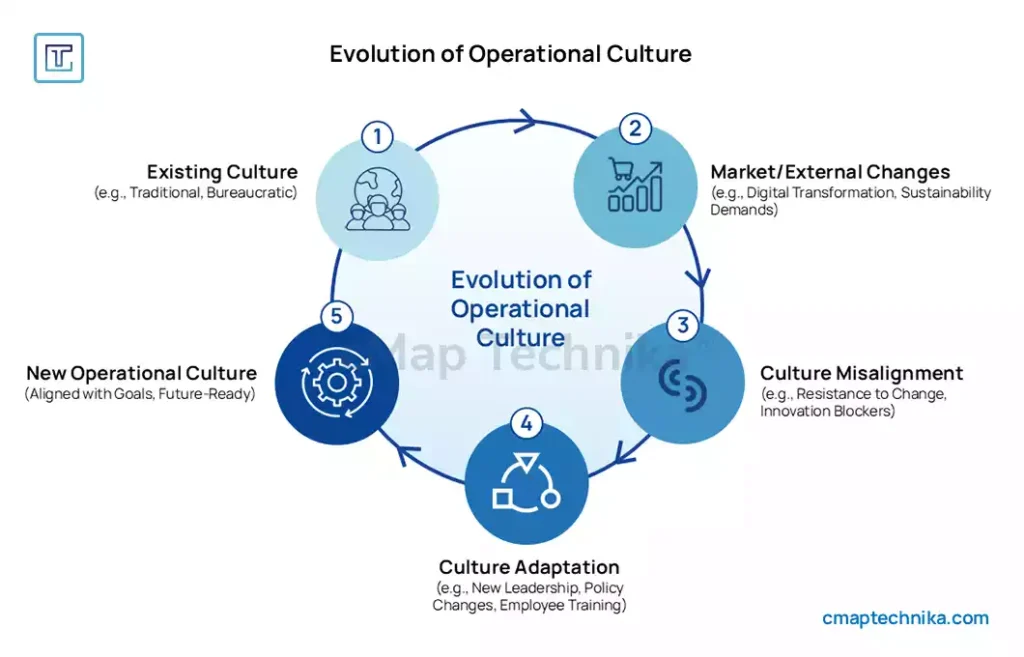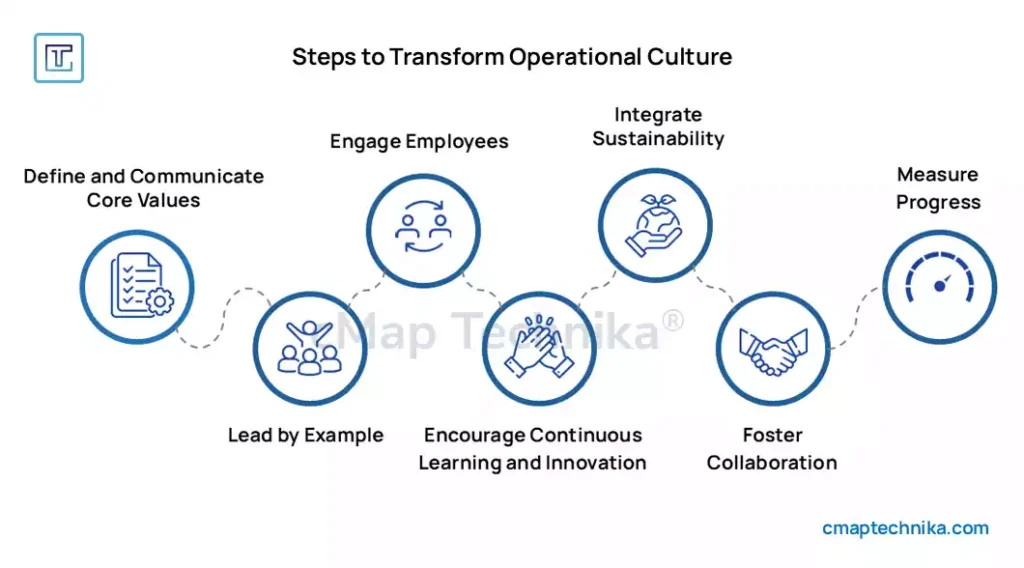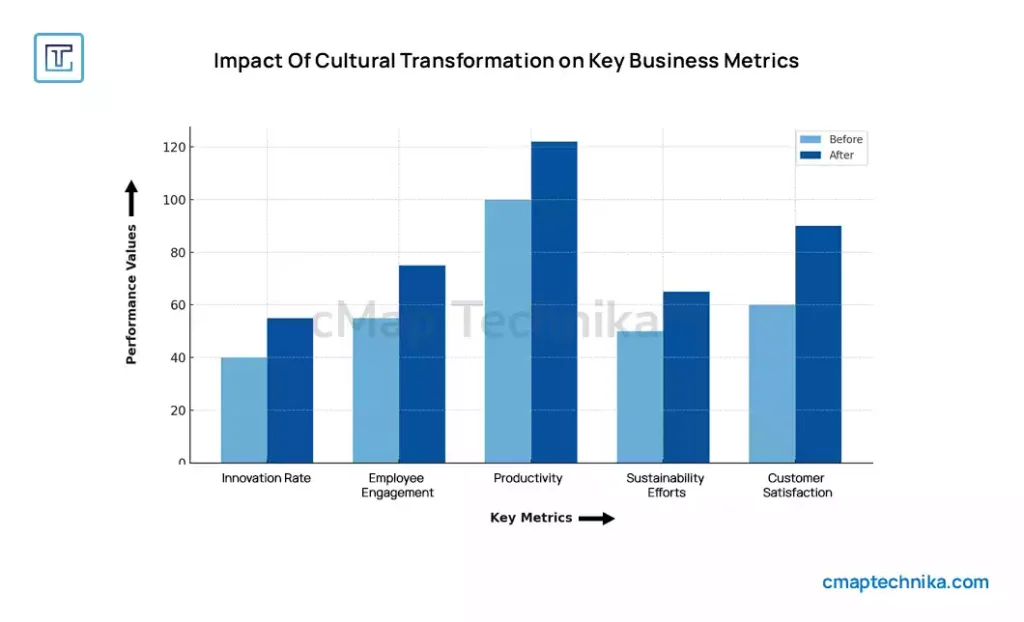In the fast-paced world of business, organizations are constantly faced with the challenge of adapting to change. From technological advancements to shifting societal expectations, the forces driving change are relentless. However, one of the most significant drivers of long-term success is often overlooked: organizational culture. The way an organization operates – its core beliefs, practices, and behaviors – can play a decisive role in shaping its future. A shift in operational culture, aligned with sustainability and innovation, has the power to revolutionize operations, boost efficiency, and create lasting impact. This article explores how such a cultural transformation can supercharge business operations and enable organizations to sustain long-term growth.
Understanding Operational Culture
Operational culture is the heartbeat of an organization. It encompasses the shared values, norms, attitudes, and behaviors that guide how individuals within a company work together to achieve their goals. From leadership style to day-to-day communication, operational culture influences every aspect of business life. It determines how decisions are made, how employees collaborate, and how the organization responds to challenges.
For example, a company with a culture that prioritizes innovation will encourage its employees to take calculated risks, experiment, and learn from failure. In contrast, an organization with a more rigid culture might discourage risk-taking, resulting in stagnation. The strength of a company’s operational culture lies in its ability to align the workforce with the broader mission, turning individual actions into collective success.
However, over time, an organization’s operational culture may become outdated or misaligned with its strategic goals. As market dynamics evolve, so must the culture that drives operational decisions. Without change, organizations may struggle to keep pace with technological developments, sustainability goals, and the shifting needs of their customers and employees.
The Need for Cultural Transformation

In today’s business environment, organizations face multiple pressures that necessitate a cultural shift. These pressures include the rapid adoption of new technologies, the increasing importance of sustainability, and the changing expectations of the workforce.
One of the most significant drivers of cultural transformation is technological advancement. From artificial intelligence to automation, new technologies are reshaping industries and altering the way businesses operate. As companies adopt these technologies, they must also evolve their culture to ensure that innovation is embraced. A culture that is resistant to change or focused on maintaining the status quo will struggle to integrate new technologies effectively. Conversely, a culture that prioritizes agility, learning, and experimentation will be better equipped to leverage technology for operational efficiency.
Sustainability is another critical factor driving the need for cultural transformation. Consumers, investors, and regulators are increasingly demanding that companies operate responsibly, with a focus on environmental and social issues. Companies that fail to align their operations with sustainability goals may face reputational damage, regulatory penalties, or a loss of market share. Operational culture plays a crucial role in integrating sustainability into business practices. A culture that values sustainability encourages employees to seek innovative solutions to environmental challenges and adopt practices that reduce waste, conserve resources, and promote social equity.
Additionally, the modern workforce expects more than just a paycheck. Employees today seek purpose-driven organizations that align with their values. A company with a strong operational culture that prioritizes collaboration, inclusivity, and transparency will not only attract top talent but also retain employees who are motivated and engaged. This is particularly important as the competition for skilled workers intensifies.
Lastly, the ability to navigate uncertainty is more important than ever. Whether it’s a global crisis, economic downturn, or industry disruption, organizations with resilient operational cultures are better positioned to adapt and thrive. A culture that fosters collaboration, open communication, and adaptability enables businesses to respond quickly to changing circumstances and continue to grow, even in the face of adversity.
Steps to Transform Operational Culture

The journey toward transforming operational culture begins with a clear vision. Leaders must articulate why the cultural shift is necessary, how it aligns with the organization’s strategic goals, and what the end result will look like. This vision should be compelling and inspire all levels of the organization to get on board with the transformation. Without a clear sense of direction, the change will be difficult to implement and sustain.
Leading by example is another crucial aspect of cultural transformation. The behaviors and attitudes of leadership set the tone for the entire organization. When leaders demonstrate a commitment to the cultural shift, it encourages others to follow suit. For example, if leadership prioritizes collaboration, open communication, and transparency, employees will be more likely to adopt these values in their own work. Leaders must also be willing to invest in the resources and support needed to make the cultural transformation successful.
Employee engagement is key to ensuring that the cultural shift takes root at all levels of the organization. Cultural transformation is not something that can be imposed from the top down; it requires buy-in from everyone. Employees must be actively involved in the process, contributing ideas, providing feedback, and taking ownership of the changes being made. This creates a sense of collective responsibility for the transformation, making it more likely that the new culture will stick. Engaging employees also means providing opportunities for growth and learning. When employees feel valued and have a clear path for development, they are more likely to contribute to the success of the cultural shift.
Another important element of cultural transformation is fostering a culture of continuous learning and innovation. In today’s rapidly evolving business environment, organizations must constantly adapt to stay competitive. This requires a culture that encourages curiosity, experimentation, and learning from failure. Companies should invest in training programs that help employees acquire new skills and knowledge, particularly in areas like digital literacy, sustainability practices, and emerging technologies. Additionally, creating a safe space for experimentation allows employees to take risks without fear of failure, which can lead to breakthrough innovations.
Sustainability must also be integrated into the very fabric of the organization’s culture. Organizations that prioritize sustainability not only benefit the environment but also enjoy long-term financial rewards. This shift requires embedding sustainability into every aspect of operations, from supply chain management to product design. It also means empowering employees to come up with innovative solutions to environmental and social challenges. A culture that embraces sustainability will attract customers and investors who are committed to responsible business practices.
Collaboration is another cornerstone of operational culture transformation. In a rapidly changing business world, organizations need to be agile and responsive. This requires seamless collaboration across departments, teams, and geographies. By breaking down silos and fostering a more collaborative environment, organizations can harness the collective expertise of their workforce, leading to more creative solutions and faster problem-solving.
Finally, measuring progress is essential to ensure that the cultural transformation is moving in the right direction. This requires setting clear goals and tracking performance over time. These metrics should not just focus on financial results but also on factors like employee satisfaction, sustainability outcomes, and innovation. Regularly evaluating the culture and making adjustments as needed ensures that the transformation remains on track and continues to deliver results.
The Impact of a Transformed Operational Culture

A successful cultural transformation can have profound and far-reaching effects on an organization. One of the most significant outcomes is improved efficiency and performance. A culture that fosters innovation, collaboration, and continuous improvement leads to better resource management, streamlined operations, and faster decision-making. As employees work together more effectively, they are able to deliver higher-quality results in less time, driving productivity and operational excellence.
Employee engagement and retention also see a significant boost. When employees are engaged and aligned with the company’s mission, they are more motivated to contribute to the organization’s success. A strong operational culture that prioritizes transparency, respect, and inclusivity creates a positive work environment where employees feel valued and supported. This leads to higher retention rates, reduced turnover, and a more committed workforce.
Sustainability becomes a key driver of profitability as well. Companies that integrate sustainable practices into their operations often find that these practices not only reduce costs but also open up new revenue streams. For instance, companies that invest in energy-efficient technologies or adopt circular economy principles may reduce waste and cut down on energy costs. Furthermore, organizations that prioritize sustainability are often able to charge premium prices for their products, as consumers increasingly demand eco-friendly and socially responsible options.
Brand reputation is another area that benefits from a cultural transformation. Companies with a strong operational culture that prioritizes sustainability, innovation, and employee well-being are often viewed more favorably by customers, investors, and the public. This can lead to increased customer loyalty, new business opportunities, and improved relationships with stakeholders. A positive reputation also enhances a company’s ability to attract top talent, further strengthening its competitive edge.
Finally, organizations with a resilient and adaptable operational culture are better positioned to navigate uncertainty. In a world where disruption is inevitable, businesses that embrace change and empower their employees to respond proactively are far more likely to succeed in the long run. A culture of resilience ensures that the company can not only survive crises but also emerge stronger from them.
Conclusion
Transforming operational culture is a journey that requires commitment, vision, and a strategic approach. The process is not without its challenges, but the rewards are significant. By fostering a culture of innovation, sustainability, collaboration, and continuous learning, organizations can create lasting value, drive sustainable growth, and remain competitive in an ever-changing world. When the operational culture is aligned with the organization’s goals and values, the results are far-reaching, influencing every aspect of the business and ensuring long-term success.







